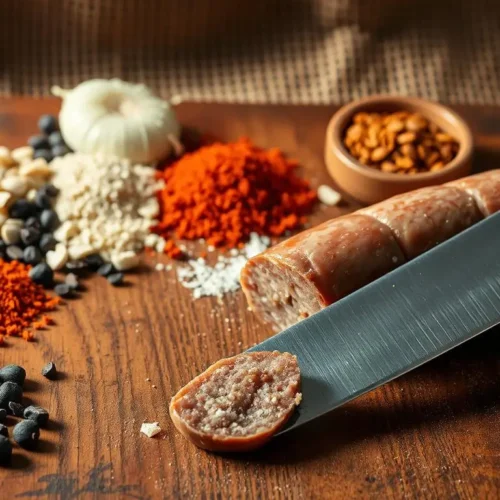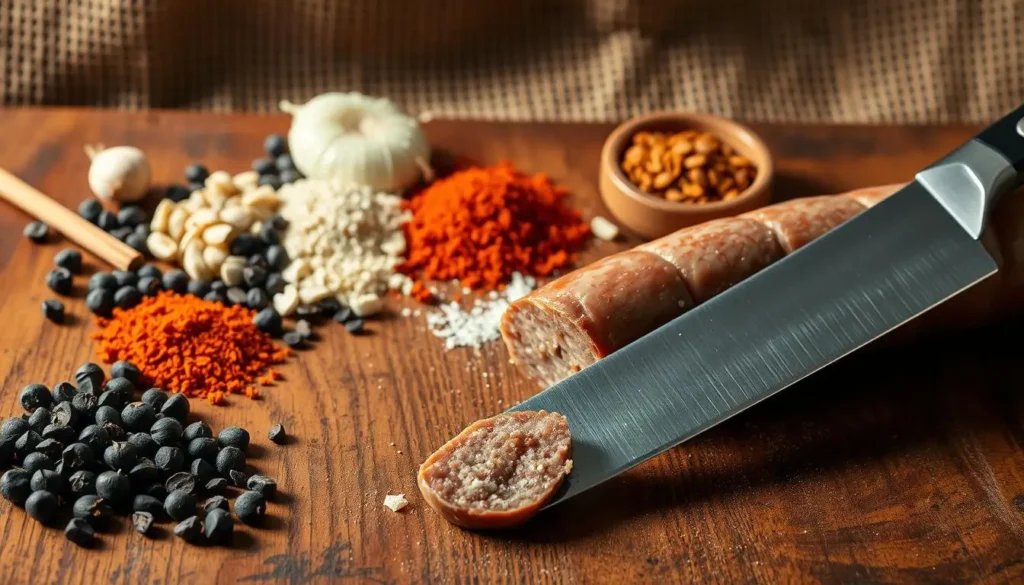Table of Contents
The smell of sizzling beef sausage recipes reminds me of weekend family breakfasts. Growing up, watching my grandmother make her famous beef sausage was magical. It sparked my love for cooking at home. Now, I’m excited to share how to make tasty beef sausage in your kitchen.
Making homemade beef sausage is more than just cooking—it’s an experience. You get to choose every ingredient, flavor, and quality. Whether you love cooking or are just starting, making beef sausage at home is simple.
In this guide, we’ll cover everything you need to know about making homemade beef sausage. You’ll learn how to pick the right meat cuts and seasonings. Soon, you’ll be a pro at making sausages.
Key Takeaways
- Create custom beef sausage with total ingredient control
- Learn professional sausage-making techniques at home
- Discover versatile beef sausage recipe variations
- Understand essential equipment and preparation methods
- Explore flavor profiles from around the world
Essential Ingredients for Homemade Beef Sausage
Making delicious beef sausage at home needs the right ingredients and tools. Knowing the key parts is crucial for a tasty treat.
Choosing the Right Meat Cut
Choosing the perfect beef cut is key for great sausage. Experts say to use:
- Chuck roast (85% lean ground beef)
- Prime or Choice grade cuts for better marbling
- Combination of lean and fatty meat for optimal texture
Required Spices and Seasonings
Boost your sausage’s taste with these spices:
| Spice | Quantity |
|---|---|
| Kosher Salt | 1.5 tablespoons |
| Ground Coriander | 2 teaspoons |
| Black Pepper | 2 teaspoons |
| Dried Oregano | 2 teaspoons |
| Fennel Seeds | 1 teaspoon |
Equipment and Tools Needed
Get quality tools for the best results:
- Meat grinder
- Sausage stuffer
- Casings (16 ft recommended)
- Kitchen scale
- Sharp knife
Pro tip: Let your sausage mix rest for hours or overnight to improve flavor.
The Best Beef Sausage Recipes for Beginners
Starting with homemade beef sausage recipes might seem tough. But, with the right tips, you’ll soon make tasty sausages. Whether you’re after a hearty beef breakfast sausage or new tastes, these easy recipes will guide you.
A classic beef breakfast sausage recipe is a great place to begin. It’s quick to make and serves 6. The secret to great sausage is the right mix of meat and fat. Aim for 25% to 30% fat for the best taste and texture.
Essential Ingredients for Beginners

Delicious Beef Sausage Recipes at Home
Equipment
- Large Mixing Bowl For combining the sausage mixture.
- Sausage Stuffer or Piping Bag For filling the casings.
- Meat Grinder (Optional) If grinding your own beef and fat.
- Cutting Board & Sharp Knife For chopping garlic and herbs.
- Measuring Cups & Spoons For accurate portioning of spices.
- Grill, Skillet, or Oven For cooking the sausages.
- Tongs To flip the sausages while cooking.
- Instant-Read Thermometer To check internal temperature for doneness.
- Plate or Platter For resting and serving the sausages.
Ingredients
For the Sausage Mixture:
- 1 lb ground beef 80/20 lean-to-fat ratio
- ½ lb beef fat or substitute with 80/20 ground beef
- 2 cloves garlic minced
- 1 tablespoon smoked paprika
- 1 teaspoon salt
- ½ teaspoon black pepper
- 1 teaspoon dried oregano
- 1 teaspoon dried thyme
- ½ teaspoon cayenne pepper optional, for spice
- 1 tablespoon Worcestershire sauce
- ¼ cup cold water
- Natural hog casings rinsed and soaked
For Cooking & Serving:
- 1 tablespoon olive oil for grilling or frying
- Mustard ketchup, or BBQ sauce (optional)
- Buns sauerkraut, or caramelized onions for serving
Instructions
Prepare the Sausage Mixture:
- In a large bowl, combine ground beef, beef fat, minced garlic, smoked paprika, salt, black pepper, oregano, thyme, cayenne pepper, and Worcestershire sauce.
- Mix well using your hands until all the ingredients are evenly distributed.
- Gradually add cold water while mixing to ensure moisture and binding.
Stuff the Sausages:
- Attach a sausage stuffer or use a piping bag to fill the hog casings with the sausage mixture.
- Twist into 4-5 inch sausages and tie the ends securely.
Rest the Sausages:
- Let the sausages rest in the refrigerator for 1-2 hours (or overnight) to allow the flavors to meld.
Cook the Sausages:
- Grill Method: Preheat the grill to medium heat and cook the sausages for 15-20 minutes, turning occasionally until evenly browned and fully cooked (internal temperature of 160°F / 71°C).
- Pan-Fry Method: Heat olive oil in a skillet and cook the sausages over medium heat for 20-25 minutes, turning occasionally.
Serve & Enjoy:
- Serve hot with buns, mustard, ketchup, sauerkraut, or caramelized onions.
Video
Notes
- Calories: ~390 kcal
- Protein: ~25g
- Carbohydrates: ~2g
- Fiber: ~0.5g
- Sugar: ~1g
- •Fat: ~30g
- Saturated Fat: ~12g
- Sodium: ~750mg
- Iron: ~3mg
- Potassium: ~350mg
If you like Italian-style beef sausage, you can tweak the basic recipe. Pro tip: Keep your meat cold (around 32°F) before grinding. This helps avoid smearing and ensures the best texture.
Simple Cooking Method
- Mix ground beef with seasonings
- Form into patties or stuff into casings
- Cook for 10-15 minutes until fully done
- Internal temperature should reach 160°F
Remember, making beef sausage takes practice. Don’t worry if your first batch isn’t perfect. With each try, you’ll get better and more confident in your sausage-making skills.
Understanding Different Sausage Casings and Their Uses
Making tasty beef sausages begins with picking the right casings. The casing you choose can change how your sausages taste and feel.
Learning about casings is key. There are three main types: natural, artificial, and synthetic. Each has its own benefits for making sausages.
Natural vs. Synthetic Casings
Natural casings give sausages a traditional taste and feel. They come from animal intestines, like sheep and hog. These casings are great for beef sausages because they:
- Look and taste like traditional sausages
- Let smoke and seasonings in
- Are available in different sizes for various sausage types
Synthetic casings, on the other hand, are more consistent and easy to use. Collagen casings from cow hide give sausages a uniform shape. Cellulose casings are best for big batches.
Preparing Casings for Stuffing
Getting your casings ready is important for making sausages. Here’s how to prepare natural casings:
- Wash casings with cold water
- Soak them in water for 30 minutes to make them soft
- Check for any damage
- Flush them with water to get rid of salt and dirt
Storage and Handling Tips
To keep your casings in good shape, store them right. Natural casings should be kept cold, between 40-50°F. Use them within a year if they’re packed in salt. Synthetic casings need less care.
Choosing the right casing can make your homemade beef sausages truly special!
Step-by-Step Grinding and Mixing Process
Mastering beef sausage grinding needs precision and skill. Success depends on the right temperature and texture. It’s key to keep meat cold for the best sausage mix.
Here are the essential steps for beef sausage grinding:
- Chill meat to around 30°F before grinding
- Select the appropriate grinder plate size
- Ensure equipment is clean and cold
- Cut meat into uniform chunks for consistent grinding
The perfect meat to fat ratio for mixing beef sausage is 70% meat to 30% fat. This mix makes sausages juicy, flavorful, and has great texture.
| Meat Cut | Fat Ratio | Recommended Use |
|---|---|---|
| Chuck | 80/20 | Best for sausage making |
| Sirloin | 90/10 | Leaner option |
| Short Ribs | 80/20 | Rich flavor profile |
When grinding, mix until the sausage holds together when pressed. This shows the meat is well mixed. You want a sticky paste that keeps the sausages in shape.
Pro tip: Use kosher salt at 1-1.5% of the total meat weight. It boosts flavor and helps mix ingredients. For 5 pounds of meat, use about 2 tablespoons of salt.
Traditional Beef Sausage Recipes From Around the World
Exploring global beef sausage recipes is a tasty trip through different cultures. Old fashioned beef sausage recipes show the unique tastes and cooking ways of each region. They use special ingredients and methods to make delicious beef sausages that food lovers enjoy.
Mediterranean-Style Beef Sausage
The Mediterranean is known for its amazing beef sausage recipes. Loukaniko, a Greek-style beef sausage, is famous for its special mix of ingredients:
- Fresh orange zest for bright citrus notes
- Chopped leeks for subtle onion flavor
- Red wine for depth and complexity
- Dried herbs like oregano and thyme
American Breakfast Sausage
Classic American beef sausage recipes add warmth to breakfast. They mix spices that make a rich flavor:
- Ground sage for traditional taste
- Maple-inspired sweetness
- Black pepper for subtle heat
- Subtle garlic undertones
German-Inspired Bratwurst
German beef sausage recipes make a bold beef version of traditional pork bratwurst. They are known for:
- Coarse meat grind for rustic texture
- Marjoram and nutmeg seasoning
- White wine for moisture and flavor
- Careful spice balance
Making these international beef sausage recipes at home lets you try global flavors. It also gives you the joy of making your own food.
Tips for Seasoning and Flavoring Your Sausages

Mastering beef sausage seasoning is an art that turns simple meat into a culinary masterpiece. The right mix of spices can make your homemade sausages truly stand out. It’s all about finding the right balance of flavors to impress your loved ones.
Start with the basic seasoning ratios when flavoring beef sausage. For every kilogram of meat, use these amounts:
- Salt: 18-20 grams
- Black pepper: 2-3 grams
- Marjoram: 2 grams
- Mace: 0.5 grams
- Allspice: 0.5 grams
To get your seasoning just right, make a test patty before stuffing the whole batch. This way, you can tweak the spice mix and get the perfect taste. Pro tip: Cook a small amount of seasoned meat in a skillet to taste and make necessary adjustments.
Try out different spice mixes like:
- Smoked paprika for depth
- Garlic powder for richness
- Dried herbs like thyme and sage
- Red pepper flakes for heat
Evenly spreading the spices is crucial. Mix them well into the ground beef so every bite is flavorful. You want to boost the beef’s natural taste without overpowering it.
Cooking Methods and Temperature Guidelines
Cooking beef sausage needs precision and care for the best taste and texture. Whether it’s a backyard BBQ or a quick dinner, knowing how to cook beef sausage is key.
Remember, always cook beef sausage to an internal temperature of 160°F (71°C) for safety. A meat thermometer is essential to check if it’s done right.
Grilling Techniques
Grilling beef sausages brings out amazing smoky flavors. Here are some expert tips:
- Preheat grill to medium-high heat (around 400°F)
- Cook sausages for 12 minutes total, turning every 3-4 minutes
- Avoid direct high flames to prevent casing splits
- Use tongs for even turning and prevent puncturing the casing
Pan-Frying Methods
Pan-frying is a quick and tasty way to cook beef sausages:
- Use a non-stick skillet with light vegetable oil
- Cook on medium-low heat for even browning
- Flip sausages every 2-3 minutes
- Total cooking time: approximately 8-10 minutes
Smoking Instructions
Smoking beef sausages adds depth and complexity to their flavor. Use wood chips like hickory or applewood for the best taste. Keep the temperature around 225°F and smoke for 2-3 hours until it reaches 160°F.
Pro tip: Try different cooking methods to find your favorite way to cook beef sausage!
Common Mistakes to Avoid When Making Beef Sausage

Making homemade beef sausage can be tricky, even for experienced home cooks. Knowing common beef sausage tips can help you avoid typical homemade sausage mistakes. These mistakes could ruin your culinary creation.
Temperature control is key when preparing sausages. If meat gets too warm, it can separate, making sausages dry and crumbly. Always chill your meat and equipment before starting.
- Maintain meat temperature below 40°F during preparation
- Chill grinder parts and mixing bowls before use
- Work in small batches to prevent meat from warming up
Seasoning needs precision. Uneven mixing can make sausages taste bland or too spicy. Use consistent mixing techniques to spread seasonings evenly.
Critical Sausage-Making Mistakes to Avoid
| Mistake | Consequence | Prevention |
|---|---|---|
| Overstuffing Casings | Sausage Bursting | Leave slight room for expansion |
| Incorrect Fat Percentage | Dry Texture | Maintain 20-25% fat content |
| Poor Equipment Cleaning | Bacterial Contamination | Sanitize all tools thoroughly |
When stuffing sausages, don’t pack meat too tightly. Allow room for the mixture to expand while cooking. This prevents bursting and ensures a better texture.
By understanding these beef sausage tips and avoiding common homemade sausage mistakes, you’ll be well on your way to creating delicious, professional-quality sausages right in your own kitchen.
Conclusion
Your journey to make tasty beef sausage recipes has started. Making your own beef sausage lets you try out many flavors and methods at home. You can make everything from Italian-style to spicy chorizo, making sausages that are better than store-bought ones.
Getting better at making beef sausage takes practice. Learning about spice mixes, choosing the right meat, and how to cook it will make you a pro. Don’t be shy to try new seasonings and cooking ways to find your own style.
Homemade beef sausage is very flexible. You can make breakfast links, grill hotlinks for barbecues, or even use them as gourmet pizza toppings. With time and effort, you’ll make sausages that everyone will love.
Lastly, don’t hold back from trying new things. Every batch of beef sausage is a chance to learn and get better. Start with simple recipes and then add your own twist. Your kitchen is now a place for fun and tasty adventures.

